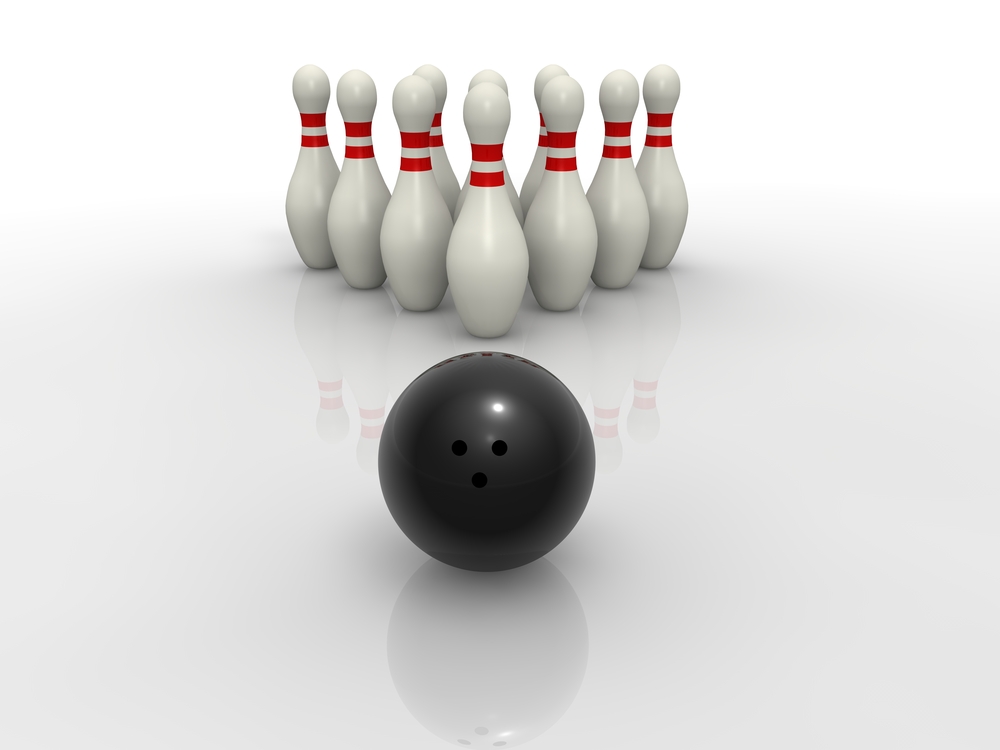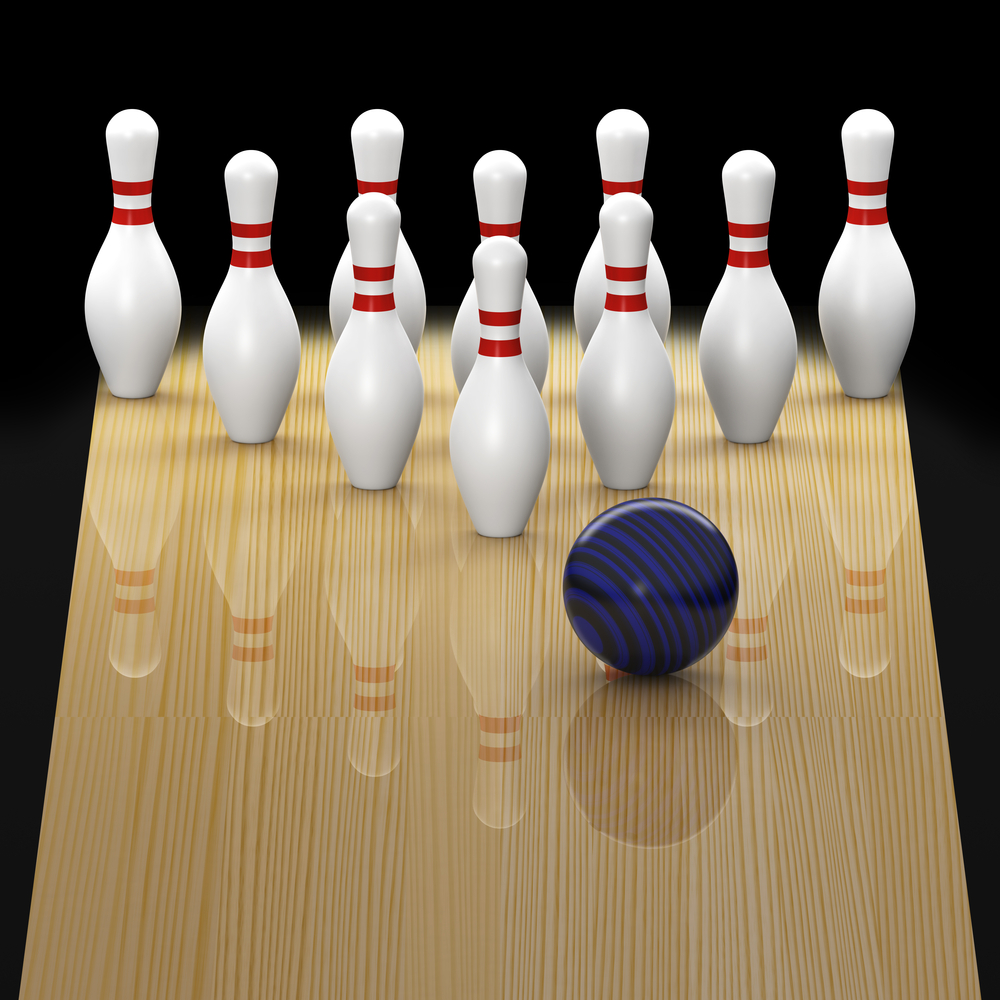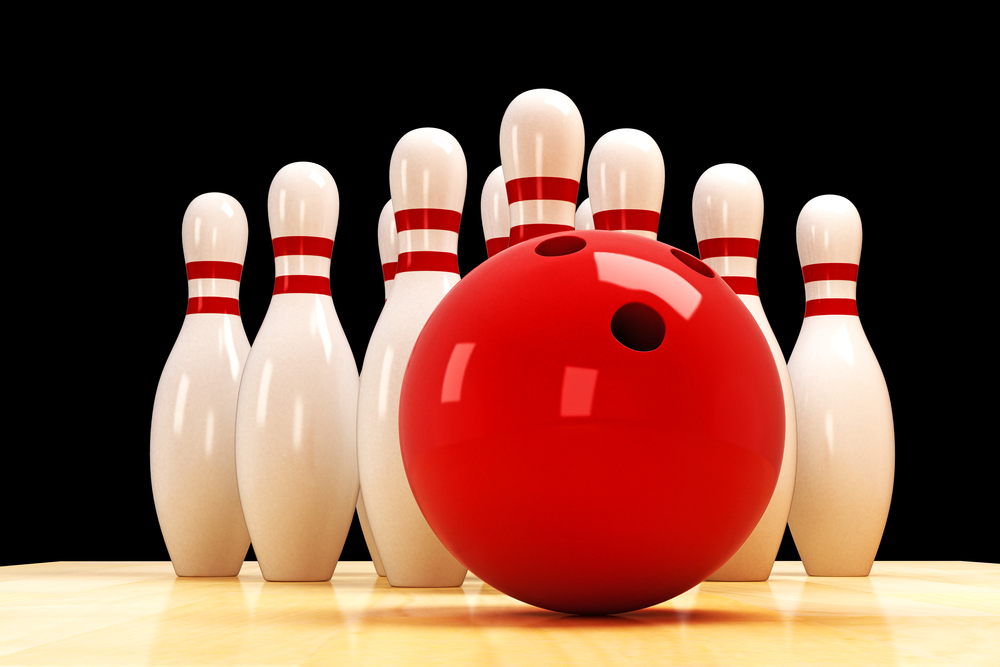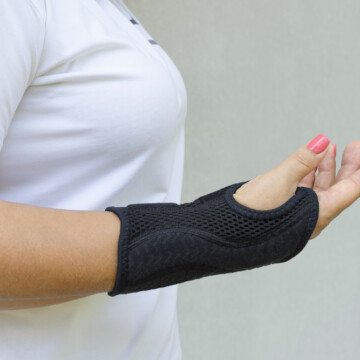
In the world of bowling, there are many different styles and types of bowling. You could identify yourself as a stroker, cranker or tweener bowler or as a bowler that doesn’t even fit in those three categories.
You could identify as a hook ball bowler or focus on keeping your bowling throws straight. Whatever you choose, there is one similarity that all bowlers share. At some point, usually at the beginning of their bowling career, they bowled straight.
As a new bowler, it is almost certain that you will begin your bowling career by learning the art of straight ball bowling. You focus on keeping your ball on the lane, practice on how to aim, and learn the proper stance of your body as well as your wrist.
These beginning practices are key in getting you set up in the art of bowling so that you can begin to learn new techniques and skills once straight bowling is mastered.
So, let's discuss some bowling tips for straight ball bowlers.
Contents
- 1 Where Should You Aim When Bowling a Straight Ball?
- 2 Where Should You Stand When Bowling a Straight Ball?
- 3 How Do I Keep My Bowling Ball Straight?
- 4 How Do You Bowl a Strike When Straight Bowling?
- 5 What's the Best Bowling Ball for a Straight Bowler?
- 6 What Is the Difference Between Straight Bowling vs Hook Bowling?
Where Should You Aim When Bowling a Straight Ball?

When aiming your ball while bowling straight, the key is aiming towards the pocket. As we mentioned above, the pocket is essentially the sweet spot of the pin formation (1 and 3 or 1 and 2).
Located behind the head pin and in front of pin three if you’re a right-handed bowler and pin two if your bowl is with your left hand, the pocket is the golden target all bowlers try to aim for. By hitting this pocket, you’re able to turn the pins against each other, using them to knock each other down and hopefully achieve a strike.
To aim for this pocket, there are a couple of things you can do. On each lane, there are a series of target marks that can be used as aiming tools.
Many straight bowlers tend to use the arrows and aim for the second arrow from their dominant side (so right-handed aim for the second arrow from the right, and left handed bowlers aim for the second arrow on their left).
They choose to use these markings to avoid the middle of the lane, which typically has a heavy saturation of oil from an oil pattern.
If these aiming marks don’t work for you, another thing you could try is to find which mark suits your style of throwing through trial and error. This does require quite a bit of practice but could be worth it if it means finding your customized targeting mark.
Key Takeaways
- Straight Bowling Technique: Focus on precision and trajectory with slower throws. Minimal to no hook is involved, aiming for accuracy rather than power or revolutions.
- Aiming for the Pocket: For optimal pin action, aim towards the pocket—the space behind the head pin, targeting between pins 1 and 3 for right-handers and 1 and 2 for left-handers. Use lane arrows for guidance, avoiding heavily oiled center lanes.
- Stance Adjustment for Accuracy: Align your stance based on your dominant hand—right or left—and adjust according to the ball's trajectory to consistently hit the pocket. Experiment to find your strike ball spot.
- Keeping the Ball Straight: Ensure a straight arm and locked wrist during the throw to minimize ball rotation. Use tools like bowling gloves for wrist stability if needed.
- Choosing the Right Bowling Ball: Opt for a ball with the suitable grip layout and coverstock suited for straight bowling. Depending on lane conditions, a conventional grip and aggressive, pearl, or plastic coverstocks are recommended.
Where Should You Stand When Bowling a Straight Ball?
Where you should stand depends entirely on how you throw your ball. If you are a right handed or left handed bowler your approaches are going to be different based on your dominant hand.
To begin, you need to find the three sets of dotted lines that are parallel to the foul line. The set of dots you use is based on how many steps you take in your approach.
If you are a right-handed bowler, you are going to need to find a dot that is just a little right to the middle dot and place your left foot so that it lines up with that dot. Left-handed bowlers need to do the same thing, and only their right foot should be a little left to the middle dot.
Once you have found your starting point go ahead and bowl, paying close attention to where your ball goes.
If you are on target, your ball should be consistently hitting the pocket (this is called your strike ball) and hopefully knocking down quite a bit of pin.
If your ball is off to the right, though, you need to adjust your stance a little to the right from your starting dot. If you're missing to the left, move a bit to the left. The goal is to find that strike ball spot and really hit that pocket consistently, so feel free to experiment and play around until you find it!
How Do I Keep My Bowling Ball Straight?
To keep your bowling ball straight during your throw, there are a few steps you need to do. First thing first, you should check your stance. For straight bowling, it is best that you are parallel to the foul line with your feet shoulder-width apart, and your foot aligned with your strike ball spot.
Next, you’ll need to pay attention to your backswing and what your bowling arm, elbow, wrist, and bowling hand are doing during your swing and release. You should start with the ball cradled to you at chest level before bringing it back in a straight backswing as you approach.
You really need to make sure that your entire arm is straight as you do to ensure a straight throw.
As you move through the motion of your throw, you need to make sure you keep your wrist, hand, and elbow locked to avoid unwanted rotation of your ball. The hardest part people seem to struggle with is keeping that wrist locked to ensure a straight throw with minimum to no rotation of the ball.
If you are really struggling with keeping your wrist and other joints locked or achieving that straight throw, there are a couple of tools you could use to help you learn. One of these tools that bowlers turn to in order to keep their wrists locked is the bowling glove.
By selecting a bowling glove with a metal bar or plate in it you are able to support your wrist and essentially lock it in place. This helps prevent any unwanted turning of the wrist to ensure that your ball is being thrown straight.
Other tools like elbow braces or grips can also help you learn and practice straight throws, depending on where you are struggling to keep your joints locked and straight.
How Do You Bowl a Strike When Straight Bowling?
As a straight bowler, there are a few key things you need to remember in order to bowl consistent strikes.
The first we have already talked about, and that is the stance. By adjusting your stance, you are able to figure out where your strike ball, the place you can consistently throw strikes from, is at. Knowing your stance is important because it gives you a baseline to make all your other adjustments.
The second we have also already talked a little about. When bowling straight, you need to aim for the pocket if you want to better your chances of getting a strike.
Approaching the pins head-on will do you very little good. Instead, you need to aim where the formation is at its weakest. By aiming at an angle and approaching the pocket, you better your chances of knocking down more pins and getting a strike.
The third and final key piece of advice is to take a look at your bowling ball.
How heavy is it?
Are you straining to throw it, or do you feel the strain more as the game goes on?
If that is the case, you should seriously consider dropping the weight of your bowling ball down a few pounds. Using too heavy a ball is not only dangerous for your body (the strain could really hurt your muscles, ligaments, and joints), but it affects your aim.
You are so busy trying to slam this heavy ball down a lane while keeping it controlled that you lose focus and control anyway!
Instead, lighten your ball a few pounds until you are at a more comfortable weight, one that is a lot easier to control. This allows you to really focus on aiming your ball instead of physically throwing it and gives you better control over the ball’s trajectory.
What's the Best Bowling Ball for a Straight Bowler?
Since straight bowlers do not have to worry about generating a large hook throw, the selection process of bowling balls is narrowed down considerably when compared to other styles. If you are a straight bowler, the main features you should make sure your bowling ball has is the right grip layout and the correct coverstock.
When bowling, straight bowlers use what is called the conventional grip, probably the most popular grip style since it is the main grip found in house balls (balls provided by bowling alleys).
This grip is triangular in formation, with the holes for the ring and middle finger close together with a hole for the thumb directly below the middle of the two.
The distance between the finger holes can vary due to the size of the bowler’s hands, but the generally triangular shape is consistent among all bowlers who use this grip layout.
The next thing to look into when customizing your bowling ball for straight bowling is the coverstock of the ball. The coverstock is the surface material of the ball and it is usually decorated in fun, swirly colors or patterns depending on the bowler’s preference.
The coverstock can be made out of different materials to create more or less friction as the ball maneuvers through the oil pattern and down the lane.
When you are straight bowling, you are going to want a bowling ball with either an aggressive coverstock for heavily saturated oil patterns (wet patterns) or a bowling ball with a pearl coverstock for low saturation (dry patterns).
If you are looking for a more universal coverstock that can help you work through a variety of oil conditions, you may want to look into a polyester or plastic coverstock.
These generic coverstocks are the most common among house balls, for good reason!
These materials are able to transverse different oil patterns well, and while they might not be tailored to tackle specific oil patterns expertly, they are a good coverstock for a general ball that you can use anywhere.
What Is the Difference Between Straight Bowling vs Hook Bowling?

The main difference between straight bowling and other bowling styles is how the balls are thrown. When you focus on bowling straight your ball has little to no hook, you simply bowl in a straight line.
There is, of course, nothing wrong with this since bowling straight is certainly a hard skill to master, even professional bowlers have a hard time aiming accurately from time to time.
With straight bowling, you generally have slower throws that focus mainly on accuracy and trajectory instead of power or revs. Revs is short for revolutions or how many times the ball turns on its axis.
This usually means that while you work on hitting your mark your ball typically lacks the power it needs to blast through the pins and knock them down in one throw. So while strikes are possible for straight bowling they tend not to happen as often as with hook bowling.
Hook bowling would be the opposite style of straight bowling. While this style focuses on speed and power it typically loses some of its accuracy and finesse as a result.
To hook bowl you need to throw the ball in a different way than as a straight bowler, a way that results in a spin on the ball that causes it to make an arch on the lane before breaking (or turning) toward the pocket of the pins.
The pocket is the sweet spot directly behind the head pin and between the head pin and pins 2 or 3 (for left-handed bowlers it's head pin and pin 2 and head pin and pin 3 for right-handed bowlers).
You can change how hard your ball hooks as well by changing how you deliver your ball so if you ever choose to give it a try know that there is a lot of practice ahead of you!
| Aspect | Straight Bowling | Hook Bowling |
|---|---|---|
| Throw Style | Minimal to no hook, focuses on a straight path. | Emphasizes a curved path with a spin leading to a hook. |
| Key Focus | Precision and trajectory. | Speed and power. |
| Ball Speed | Generally slower to enhance accuracy. | Faster, utilizing power to create impact. |
| Revolutions | Fewer revolutions, focusing on maintaining a straight path. | Higher revolutions to encourage the hook motion. |
| Aiming Technique | Aims directly for the pocket (between specific pins) using lane markings for guidance. | Utilizes the ball's spin to curve into the pocket from an angle. |
| Stance Adjustment | Adjust based on the trajectory towards the pocket. | May vary significantly to accommodate the hooking technique. |
| Recommended Ball | Lighter ball with a conventional grip and suitable coverstock for straight paths. | Varied based on lane conditions, often with specific compositions to enhance hook. |
| Equipment | Bowling gloves for wrist stability; elbow braces as needed. | Specific gear might include wrist supports tailored for curving throws. |
How Can I Improve My Straight Ball Bowling?
Focus on your stance, aim, and ball control to improve your straight-ball bowling. Stand parallel to the foul line with your feet shoulder-width apart, aligning your foot with your strike ball spot. Pay close attention to your backswing, ensuring your arm, wrist, and hand remain straight and locked to avoid unwanted ball rotation. Practicing consistently and considering tools like bowling gloves or elbow braces can further enhance your skill in keeping the ball straight.
Where Do You Aim When Bowling a Straight Ball?
Aim for the pocket when bowling a straight ball to achieve optimal pin action. The pocket is behind the head pin and in front of pins two and three. Right-handed bowlers should focus on the space between the one and three pins, while left-handed bowlers should aim between the one and two pins. Utilize the lane's target marks, like arrows, to enhance your aiming precision and avoid the heavily oiled center of the lane.
Can You Be a Good Bowler Bowling Straight?
Yes, you can be a proficient bowler while bowling straight. Although it's often considered a beginner's technique, mastering straight bowling requires skill and practice. Focus on accuracy and consistency, adjusting your stance and aiming technique to hit the pocket effectively. While strikes may be less frequent than hook bowling, precision and control are crucial for succeeding as a straight bowler.
How Do You Swing Straight in Bowling?
To achieve a straight swing in bowling, start with a proper stance parallel to the foul line and your feet shoulder-width apart. Hold the ball at chest level and ensure a straight backswing during your approach. Keep your bowling arm, elbow, wrist, and hand straight to avoid ball rotation. Pay attention to your release to ensure the ball travels in a straight line down the lane. Practice this motion consistently to develop muscle memory, and consider using gear like bowling gloves or elbow braces if you're having difficulty keeping your joints locked and straight, ensuring a precise and controlled straight swing.
My Final Words
Despite its simplicity, straight bowling requires a deep understanding of the nuances of the lane, your own ball, and your body. Even professional bowlers continue to refine these aspects of the game. Bowlers ensure a consistent arm swing and wrist straightness by correctly positioning the middle and ring fingers and maintaining a handshake position. Hand positioning is crucial for sending the first ball down the bowling lane on a straight path for a strike.
Opting for a lighter ball can enhance control, making it easier for bowlers to align their bowling shoulder and keep their hand and arm moving in the same direction, towards their target line. Incorporating a personal ball, ideally a plastic ball due to its straightforward ball composition, allows for better grip and fit and is pivotal for achieving precision in every throw. Whether at a local bowling alley or a professional bowling center, the principles of straight bowling serve as a foundation for both novices and experts, emphasizing accuracy over power and spin.
Kira Byrd, a Certified Fraud Examiner, holds a B.S. in Accounting from the University of Alabama at Birmingham. With a passion for bowling from her childhood, Kira has poured her expertise and personal experiences into creating and nurturing Bowling For Beginners. Kira's mission is to meet new bowlers where they are and guide them toward consistently achieving higher scores. With a focus on skill development and strategic techniques, she empowers readers to take control of their game and unlock their true potential.
Bowling For Beginners embodies strict editorial integrity, ensuring reliable and unbiased information. Kira's commitment to delivering valuable insights and practical strategies is reflected in every article. Here's an explanation of our editorial policy and how we get money.





